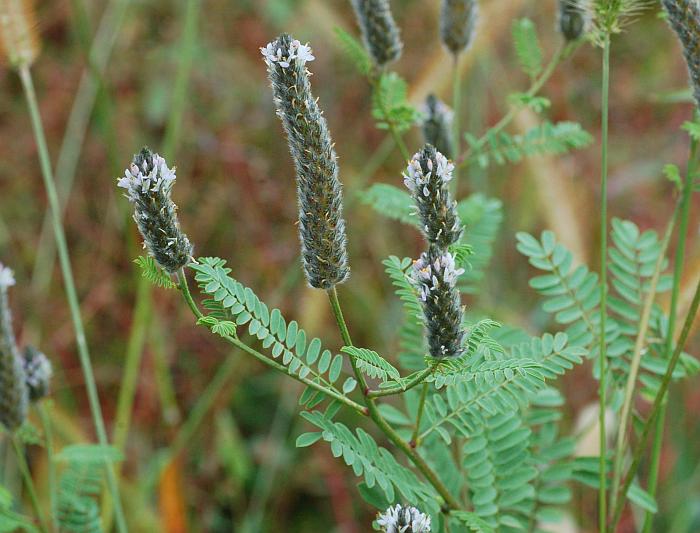Dalea leporina (Aiton) Bullock
Foxtail Dalea

Native
CC = 7
CW = 5
MOC = 18
© SRTurner
Dalea leporina (Aiton) BullockFoxtail Dalea | |
 |
Native CC = 7 CW = 5 MOC = 18 |
© SRTurner |
|
Family - Fabaceae/Faboideae Habit - Annual forb with a small, yellow-orange taproot. Stems - Strongly ascending to erect, to about 1 m, well branched above the midpoint, finely angled, glabrous, usually gland-dotted. Leaves - Alternate, odd-pinnately compound, to 10 cm, with stipules 1-3 mm long. Leaflets 13-35, to 12 mm long and 4 mm wide, roughly oblong, often folded longitudinally, tapered at the base, usually slightly notched at the tip, glabrous, with gland-dotted undersides.
Inflorescences - Dense spikes terminal on stems and branch tips, cylindrical, to 5 cm long, on stalks to 3 cm. Bracts numerous, deciduous, green or purplish tinged, gland-dotted, glabrous or hairy.
Flowers - Calyces 5-lobed, with the tube 2.2-3.0 mm long, pubescent with relatively long, silky hairs, also gland-dotted, the ribs light brown to blackish purple, the lobes 1.0-2.5 mm long, sometimes hairy and also glandular along the margins (appearing feathery). Corollas papilionaceous, white, the banner attached at the base of the stamen tube, the expanded portion 2.5-3.0 mm long, the wings attached along the side of the stamen tube, the expanded portion 2.5-3.0 mm long, the keel petals attached along the side of the stamen tube, the expanded portion 2-3 mm long. Stamens 9 or 10, the anthers blue. Fruits - Short legumes enclosed in the persistent calyx, 2.5-3.0 mm long, thin and papery for most of its length, this region with an irregular transverse band of gland dots near the tip, the apical portion thicker, hairy. Flowering - July - August. Habitat - Riverbanks, sloughs, marshes, wet prairies, disturbed areas, often in sandy substrate. Origin - Native to the U.S. Lookalikes - None close when flowering. Other info. - This attractive species is fairly uncommon in Missouri. For the most part it is found in counties bordering the major rivers (Missouri and Mississippi), usually in sandy alluvium. Its natural range includes large portions of the U.S. Midwest and southwestern regions, though its distribution in most regions is somewhat sporadic. Photographs taken at Marais Temps Clair Conservation Area, St. Charles County, MO, 9-30-2006, and Corning Conservation Area, Holt County, MO, 9-23-2016 (SRTurner). |